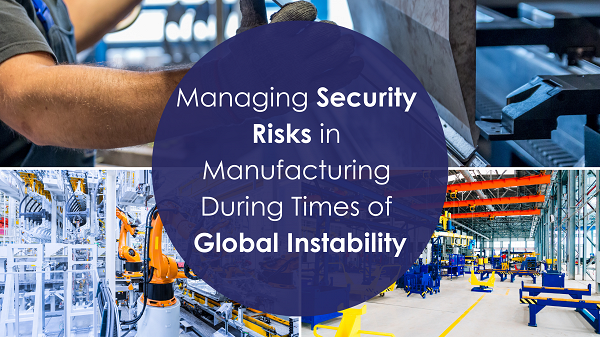Managing Security Risks in Manufacturing During Times of Global Instability

In today’s rapidly evolving global landscape, manufacturing organisations face unprecedented security challenges. Having experienced first hand the impact of global instability during my time in the British Army, I understand the critical need for robust security solutions. I have experienced first hand the impact of geopolitical tensions that disrupt operations and affect communities. This experience underscores the importance of strategic security management in safeguarding business continuity.
As a security management company specialising in manufacturing, we recognise the complex risk environment created by political, economic, and technological factors. In this blog, we will explore the key security risks facing the manufacturing sector during times of global instability and provide insights into effective management strategies.
Understanding the Sources of Global Instability
Global instability is increasingly driven by diverse factors, including geopolitical hostilities economic swings, and technological innovations. These elements are reshaping the risk landscape, making it more volatile and unpredictable. For instance, the rebalancing of military power and the rise of AI-generated cyber risks are significant contributors to this instability. Manufacturing companies must recognise these emerging threats and adopt a geo-strategic approach to risk management. By integrating security intelligence into enterprise risk management, businesses can make informed decisions that safeguard their competitive edge.
Other blogs you may be interested in:
- Why is Operational Resilience Crucial for Manufacturers During Global Instability?
- Understanding the Hidden Cost of Criminal Activity on Manufacturing Efficiency.
Cybersecurity Challenges in the Manufacturing Industry
The manufacturing sector is a prime target for cyber adversaries due to its reliance on interconnected technologies such as IoT, robotics, and automation. The Fourth Industrial Revolution has brought about a technological transformation, but it also presents significant cybersecurity risks. Legacy systems, which were not designed for internet connectivity, are particularly vulnerable to cyberattacks. Manufacturing companies must prioritise cybersecurity by implementing comprehensive strategies that encompass both operational technology (OT) and information technology (IT) security. This includes regular assessments, employee training, and the integration of cybersecurity into the organisational culture.
Other blogs you may be interested in:
- How can legacy equipment make your manufacturing facility vulnerable to cyber attacks?
- Understanding Cyber Physical Security: Essential Insights for Manufacturing Leaders
Building Resilience Through Strategic Foresight
To navigate the complexities of global instability, manufacturing organisations must develop strategic foresight capabilities. This involves scenario planning, war-gaming, and other activities that enable companies to anticipate potential threats and opportunities. By proactively identifying and addressing vulnerabilities, businesses can build resilience and ensure operational continuity. Additionally, engaging with public and private organisations that drive cybersecurity regulation can help manufacturers stay ahead of emerging threats.
Other blogs you may be interested in:
- Making the Right Choice: Why Core Values Matter in Your Security Partner.
- Securing Your Business with Legacy Equipment: Why Choose our Expertise?
Conclusion
In conclusion, managing security risks in manufacturing during times of global instability requires a comprehensive and proactive approach. By understanding the diverse sources of instability, addressing cybersecurity challenges, and building resilience through strategic foresight, manufacturing organisations can protect their operations and thrive in a volatile environment. As experts in security management, we are committed to providing the solutions and expertise needed to navigate these challenges and ensure the success of manufacturing businesses worldwide.
This content has been generated with the assistance of artificial intelligence (AI). While AI technology was used to draft and develop the initial content, it has been thoroughly reviewed, edited, and fact checked by Luke to ensure accuracy and relevance. We strive to provide high-quality and trustworthy information, but please be aware that AI-generated content may contain errors or omissions. We take full responsibility for the final content presented here and are committed to maintaining transparency and integrity in our use of AI technology





